火星 ALPO-Japan Latest

Mars Image 2020/11/05(UT)
佐藤康明,荒川 毅,柚木健吉,三品利郎,森田光治,石橋力,井上 修,長瀬雅明,阿久津富夫,栗栖 茂,西岡達志,大杉忠夫,皆川伸也,高尾幸弘,熊森照明,伊藤了史,安達 誠,尾崎公一
Kevin Quin,Randy B. Christensen,Stephen James O'Meara,Peter Edwards,Randy Tatum,Dmitry W. von Aichegg,Stanislas Maksymowicz,Siegfried Gonzi,John Sussenbach,Chris Nuttall,Gary Walker,Jacques VAN DER MEER,Christophe Pellier,Charles Galdies,Damian Peach
Y.Sato,T.Arakawa,K.Yunoki,T.Mishina,M.Morita,T.Ishibashi,O.Inoue,M.Nagase,T.Akutsu,K.Quin,S.Kurisu,R.Christensen,T.Nishioka,S.O'Meara,P.Edwards,R.Tatum,T.Ohsugi,Dmitry.W,S.Maksymowicz,N.Minagawa,S.Gonzi,J.Sussenbach,C.Nuttall,G.Walker,Y.Takao,T.Kumamori,S.Ito,M.Adachi,J.VAN DER MEER,Christophe.P,K.Ozaki,C.Galdies,D.Peach
下記リンクをクリックにて安達氏のコメント(PDFファイル)が開きます。
Click the link below to open the Comment(PDF File) by Makoto Adachi on a new page.
解説(安達)/ Comment by Makoto Adachi

気流が比較的安定していたので、約3時間の自転を撮ってみました。
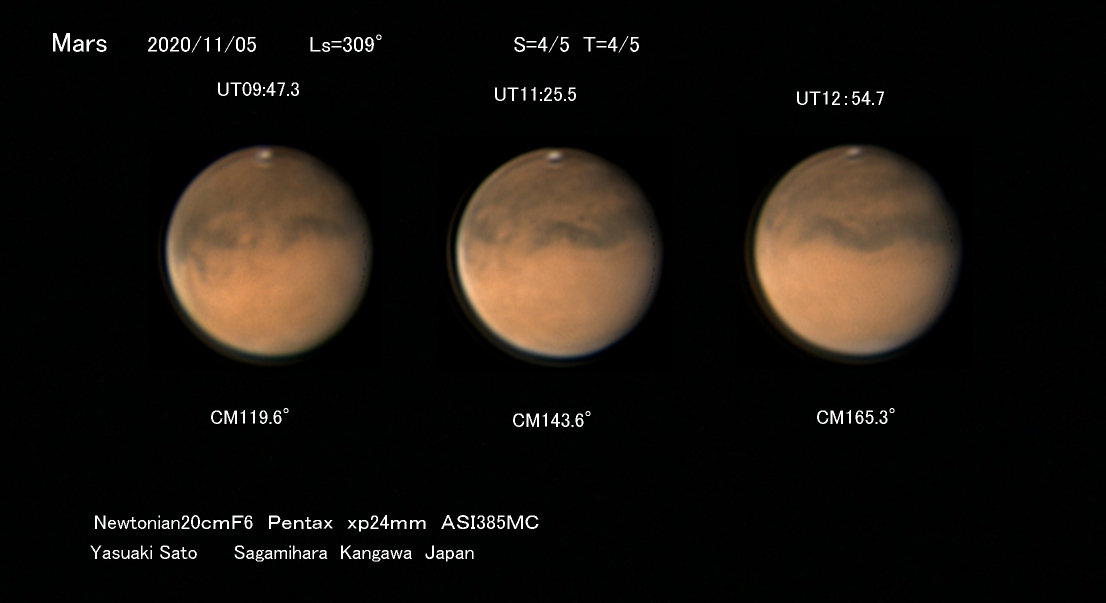 -----------------------------------------------------
[Sagamihara-shi Kanagawa-prefecture Japan]
≪神奈川県相模原市 佐藤康明≫
-----------------------------------------------------
[Sagamihara-shi Kanagawa-prefecture Japan]
≪神奈川県相模原市 佐藤康明≫
 ≪奈良県奈良市 荒川 毅≫[Tsuyoshi Arakawa:Nara Japan]
≪奈良県奈良市 荒川 毅≫[Tsuyoshi Arakawa:Nara Japan]
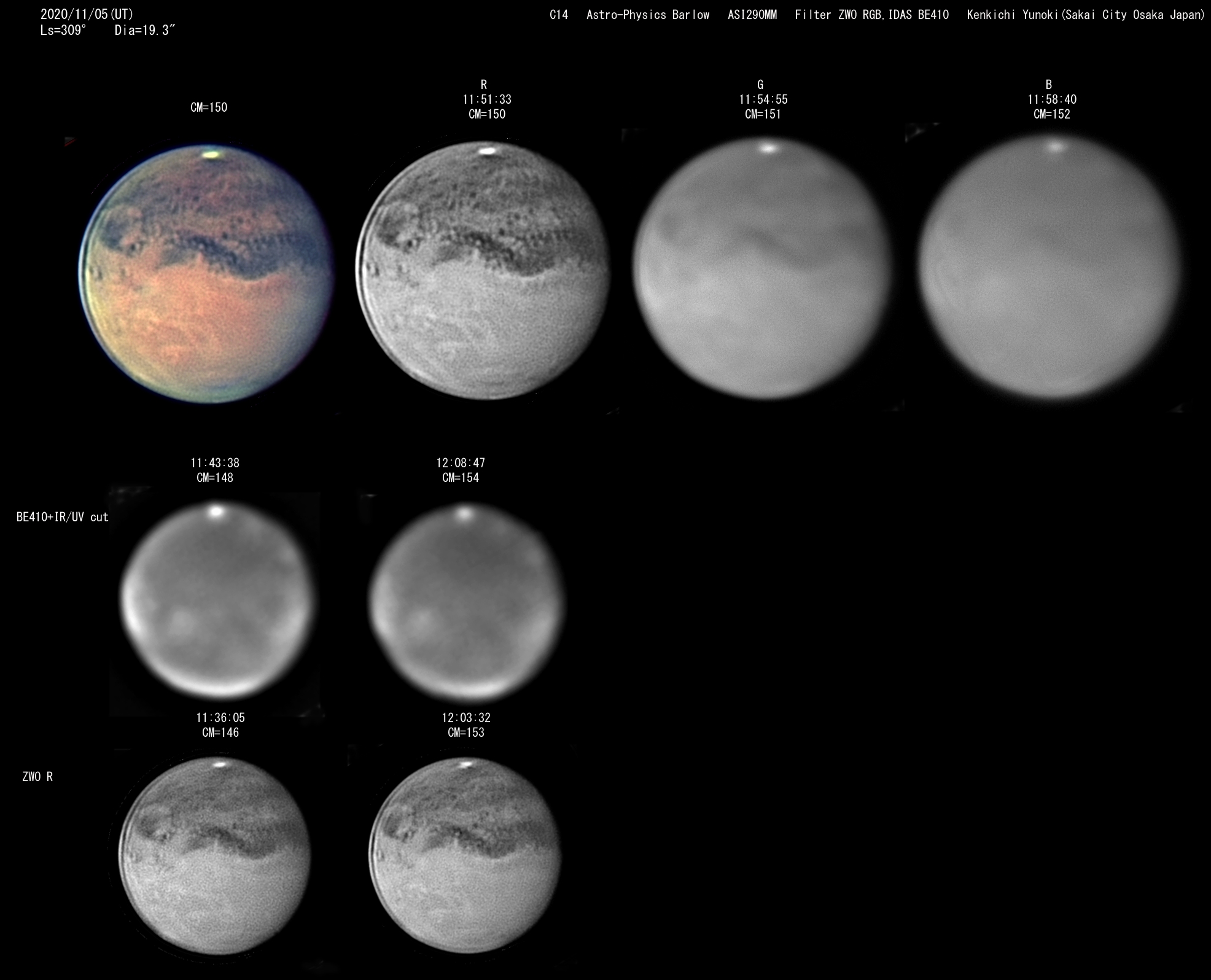 [Kenkichi Yunoki (Sakai City,Japan)]
≪大阪府 堺市 柚木健吉≫
[Kenkichi Yunoki (Sakai City,Japan)]
≪大阪府 堺市 柚木健吉≫
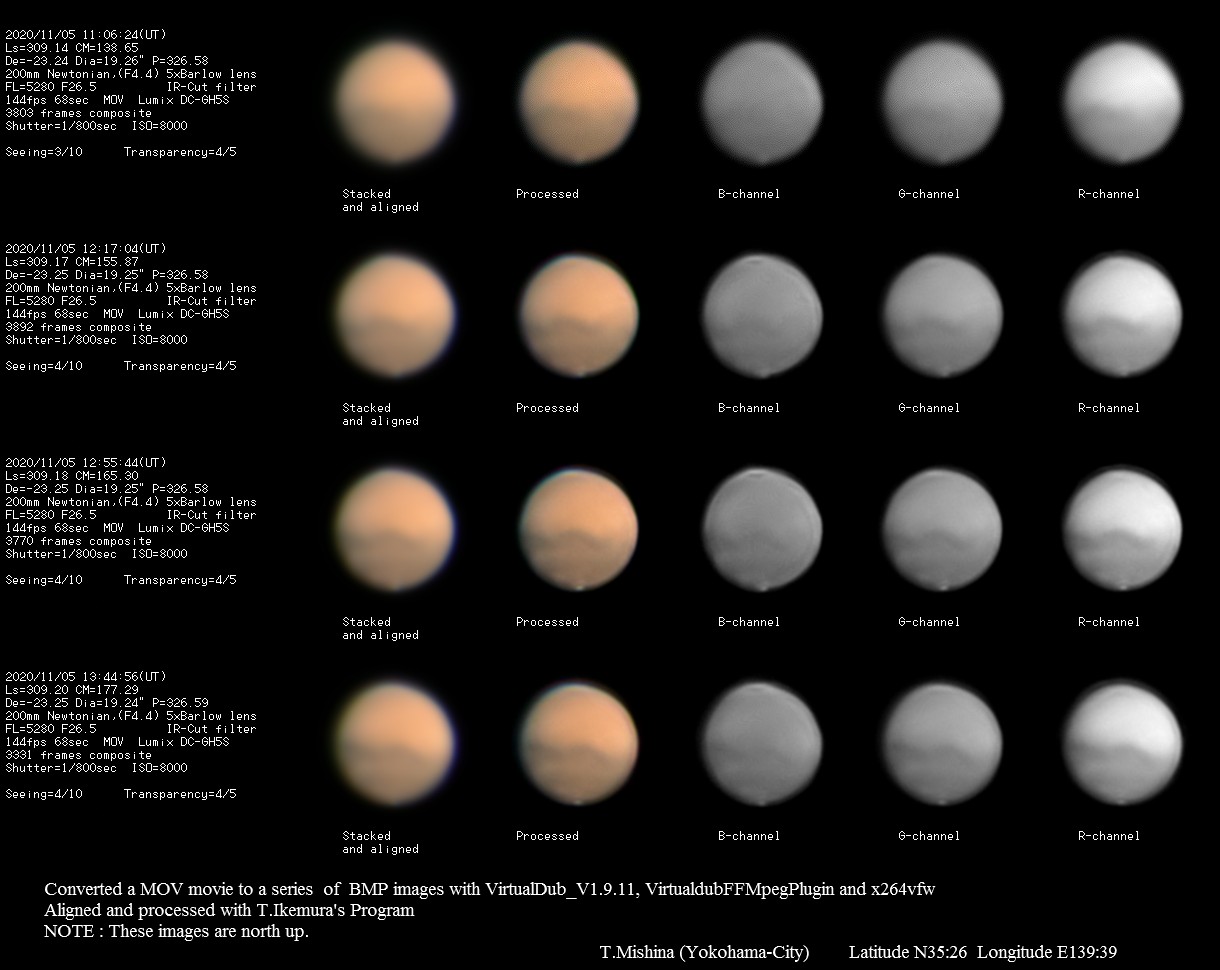 ≪神奈川県 横浜市 三品利郎≫[Toshirou.Mishina:Kanagawa Japan]
≪神奈川県 横浜市 三品利郎≫[Toshirou.Mishina:Kanagawa Japan]
シーイングはまずまずであったが、画像周縁部がクリアに出ない。ピントのわずかな狂いか光軸のずれかもしれない。それともミラーの限界か
 ≪滋賀県守山市 森田光治≫[Mitsuji Morita:Siga Japan]
≪滋賀県守山市 森田光治≫[Mitsuji Morita:Siga Japan]
少し、気流は悪い感じですが、まだ写っています。2枚目のB-390の後、高積雲か巻積雲が来てしまいました。
タルシスなどに山岳雲があるようです。明け方の雲は、あまり目立たないようです。南極冠が小さくなりました。
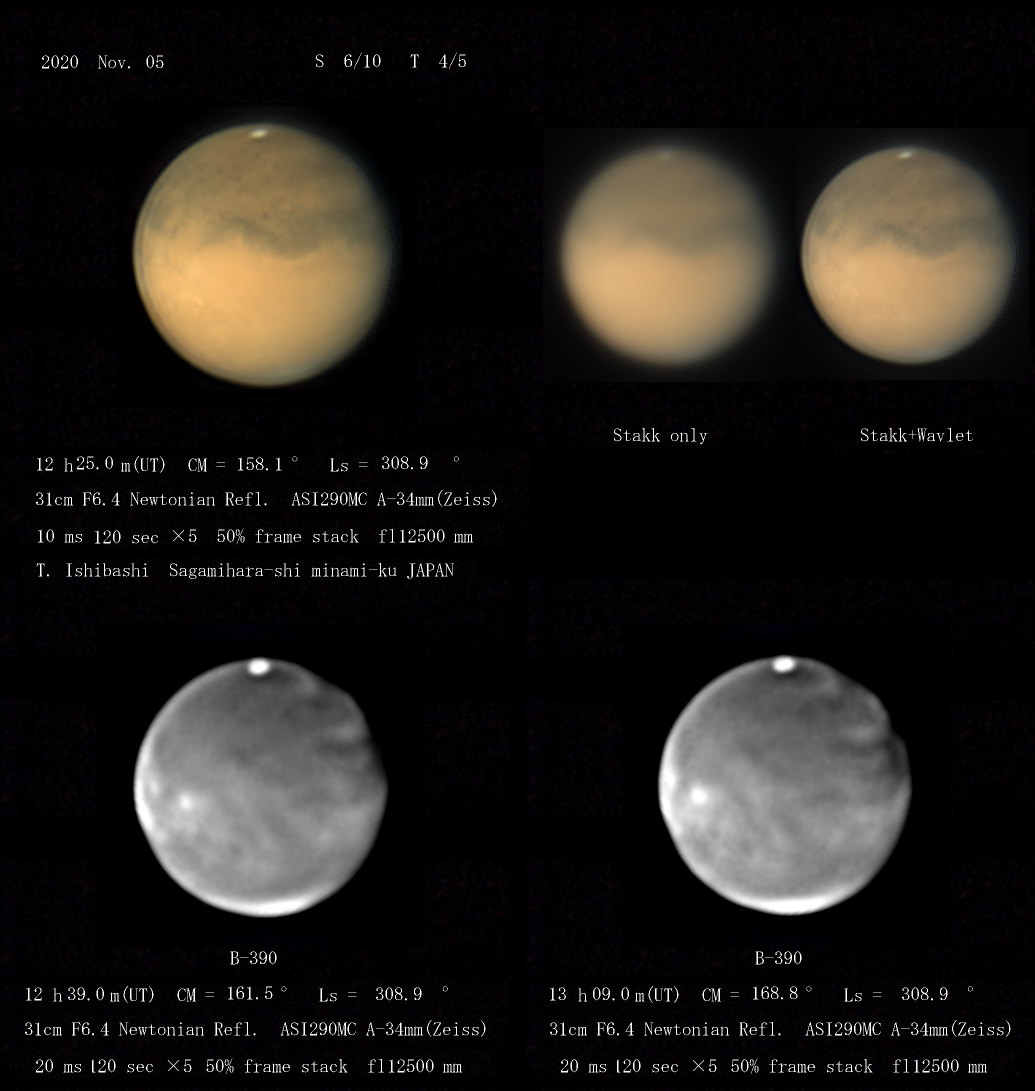 (Tutomu-Ishibashi Kanagawa-P Japan)
≪神奈川県 相模原市 石橋力≫
(Tutomu-Ishibashi Kanagawa-P Japan)
≪神奈川県 相模原市 石橋力≫
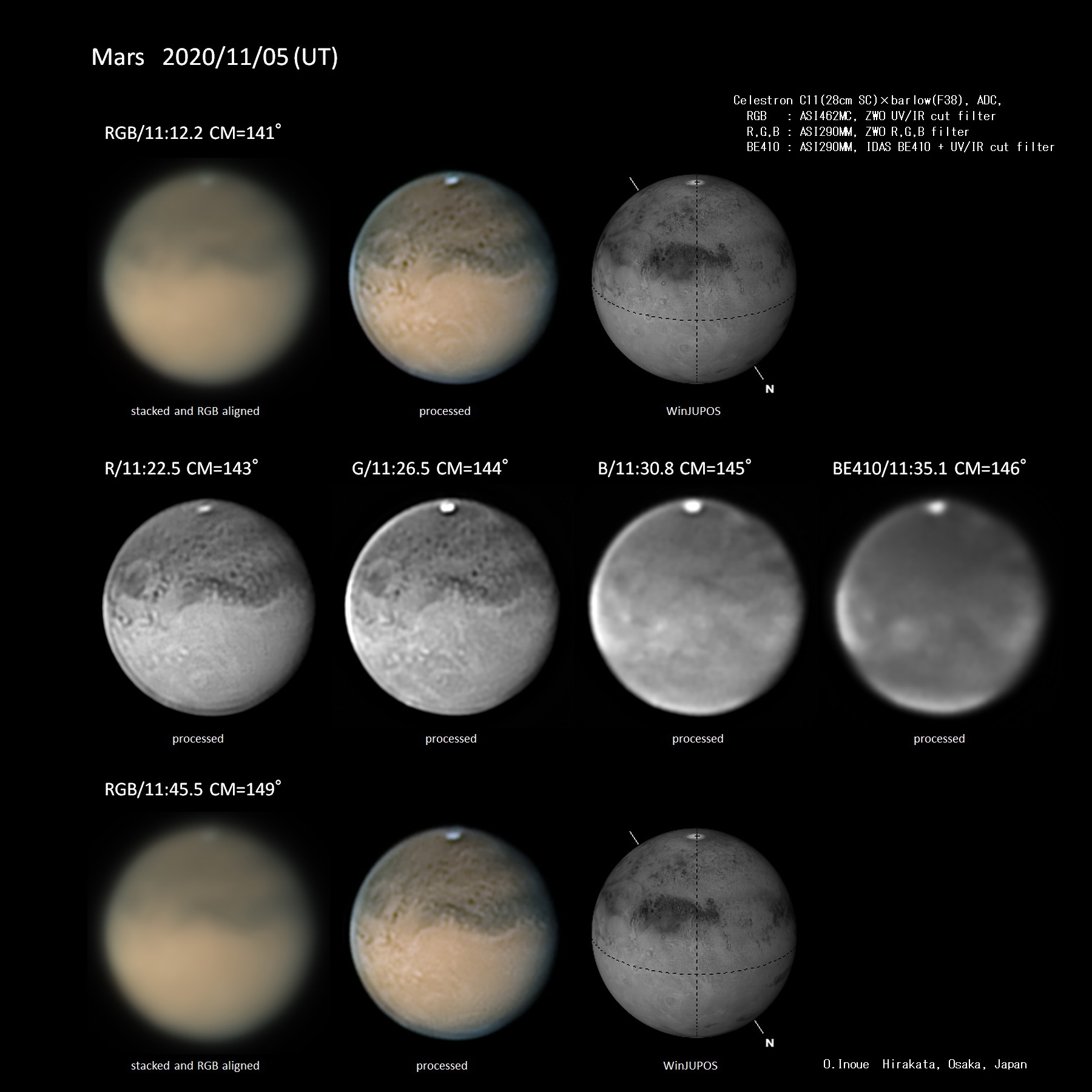 ≪大阪府 枚方市 井上 修≫[Osamu Inoue. Hirakata-shi,Osaka,Japan]
≪大阪府 枚方市 井上 修≫[Osamu Inoue. Hirakata-shi,Osaka,Japan]
雲に隠されながらもシーイングは割合と良かったです。極冠はかなり小さくなりました。
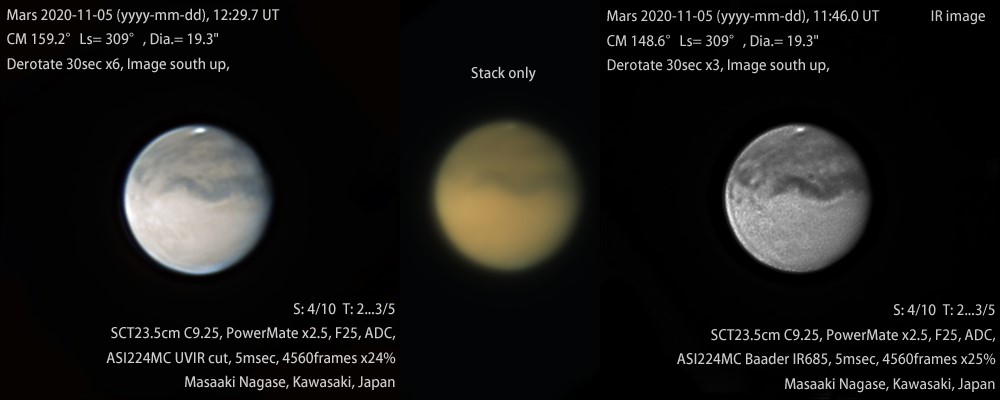 [Masaaki Nagase,Kawasaki-City,Japan]
[Masaaki Nagase,Kawasaki-City,Japan]
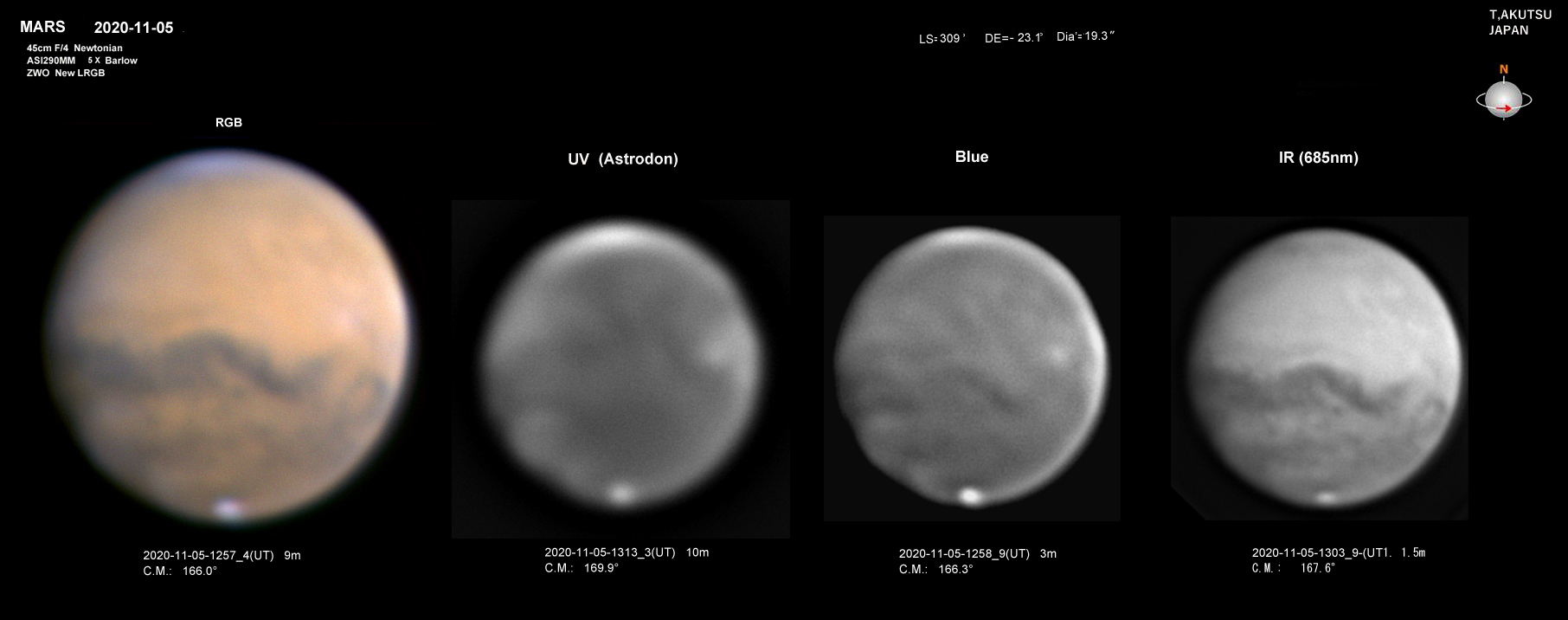 ≪茨城県 : 阿久津富夫≫
≪茨城県 : 阿久津富夫≫
A small dust cloud has appeared in Juventae Fons. The slopes of the Tharsis volcanoes are catching the morning light at upper left. Seeing 6/10 Trans 7/10
 [Kevin Quin:Vienna,VA,USA]
[Kevin Quin:Vienna,VA,USA]
Juventae Fonsに発生したダストストームが写っていると近内さんに教えて頂きました(矢印)
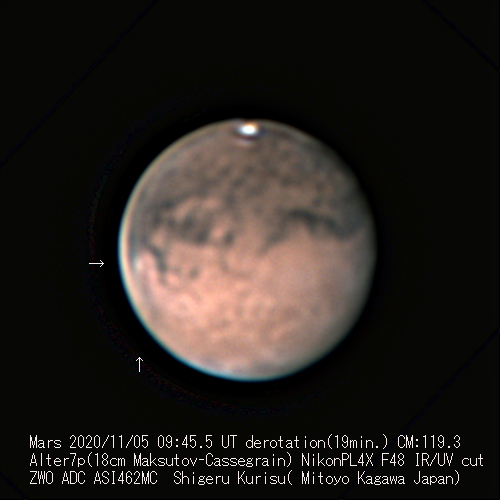 [Shigeru Kurisu,Mitoyo Kagawa,Japan]
[Shigeru Kurisu,Mitoyo Kagawa,Japan]
 [Randy B. Christensen,Livermore,California,US]
[Randy B. Christensen,Livermore,California,US]
上空をジェット気流が流れていますが思いのほか気流が良かったです。
 <<神奈川県 藤沢市 西岡達志>>[Tatsushi Nishioka. Fujisawa-city,Kanagawa,Japan]
<<神奈川県 藤沢市 西岡達志>>[Tatsushi Nishioka. Fujisawa-city,Kanagawa,Japan]
Decent seeing conditions,and Mars’s disk still appeared very mottled with faint details.
Elysium bright; Hellas appears circular; first time in a long time I have seen this appearance.
Perhaps cloud/fog/dust obscuring Peneus. Note that in the image at right at 400x,
the dark circular spot may be a dust spot on the eyepiece superimposed onto Ausonia,
where a fainter dark feature lies.
 [Stephen James O'Meara : Maun,Botswana]
[Stephen James O'Meara : Maun,Botswana]
Jittery seeing,but some details visible. Syrtis Major and Hellas Basin central,Mare Cimmerium prominent on the left.
Slight irregularity in terminator limb profile indicate hgh orthoscopic clouds?
Bad edge rind on bright limb. Wish I could avoid this!
 [Peter Edwars: West Sussex United Kingdom]
[Peter Edwars: West Sussex United Kingdom]
Plenty of cloud activity captured. I used Firecapture,Registz 5 and Photoshop CS 2 for processing.
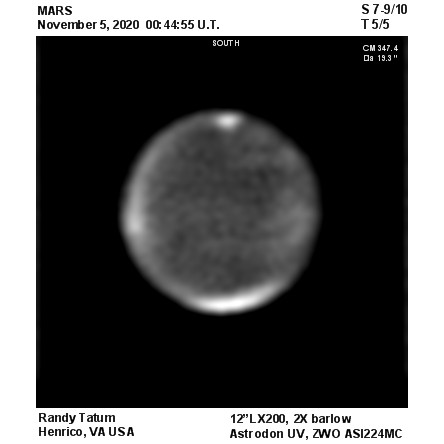
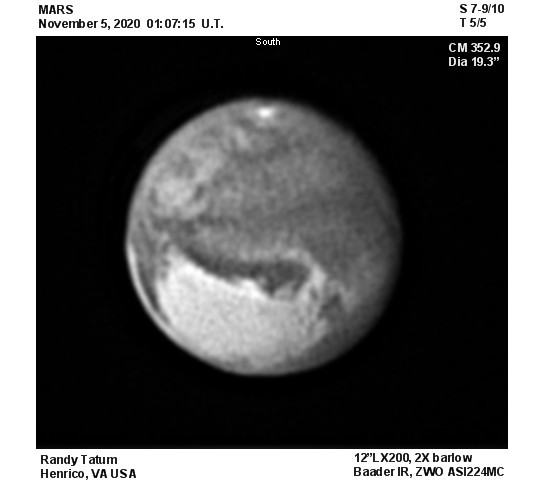
 [ Randy Tatum,Richmond,VA U.S.A]
[ Randy Tatum,Richmond,VA U.S.A]
 ≪石川県小松市 大杉忠夫≫[Tadao Ohsugi:Komatsu city Ishikawa pre,Japan]
≪石川県小松市 大杉忠夫≫[Tadao Ohsugi:Komatsu city Ishikawa pre,Japan]
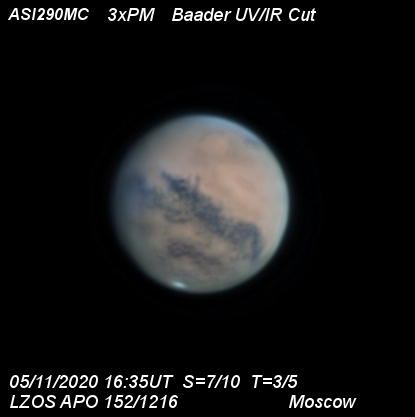 [Dmitry W. von Aichegg : Domodedovo,Moscow Russia]
[Dmitry W. von Aichegg : Domodedovo,Moscow Russia]
Here is a mars report performed with a 102mm refractor under good images on a short session.
Still the same veils at the limb and terminator,but fading compared with previous days.
The ground color appeared yellow-orange.
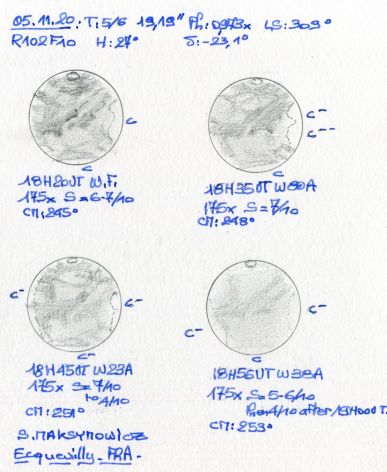 [Stanislas Maksymowicz Ecquevilly,France]
[Stanislas Maksymowicz Ecquevilly,France]
視直径が20”を切りました。なかなか好気流に出会えるのが厳しい季節になりましたがこの日は比較的安定していたようです。
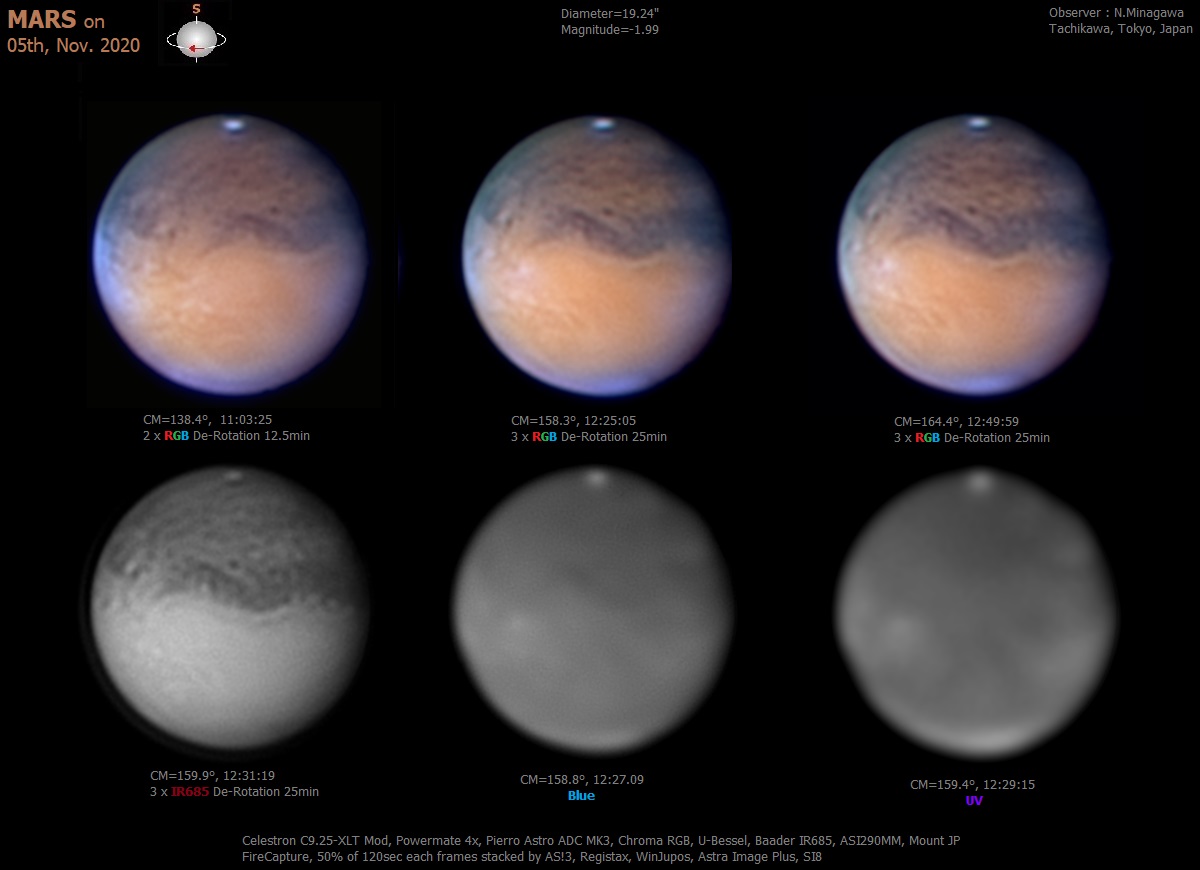 ≪東京都 立川市 皆川伸也≫[Nobuya Minagawa:Tokyo Japan]
≪東京都 立川市 皆川伸也≫[Nobuya Minagawa:Tokyo Japan]
 [Siegfried Gonzi : Exeter,United Kingdom]
[Siegfried Gonzi : Exeter,United Kingdom]
 [スセンバッハ:オランダ]
[John Sussenbach:Houten,Netherlands]
[スセンバッハ:オランダ]
[John Sussenbach:Houten,Netherlands]
The seeing started off at Ant III but improved a little in the first few minutes,
then when I inserted the W23a the view became instantly very stable and full of fine detail.
SPC uniformly oval. The morning cloud was wide,thin and grey.
While observing in W80a I did think that the southern parts of the disc might be thinly misted down to around 70°,
almost like the morning mist was extending right past the SPC,
but would want confirmation from others before really believing it.
NPH was bright bluish white,and almost invisible in the W23a.
The Evening cloud was bright bluish white,and confined to the limb with no discreet clouds visible.
Plenty of faint markings and fine details became visible across the disc in the W23a,
Certainly a very enjoyable view!
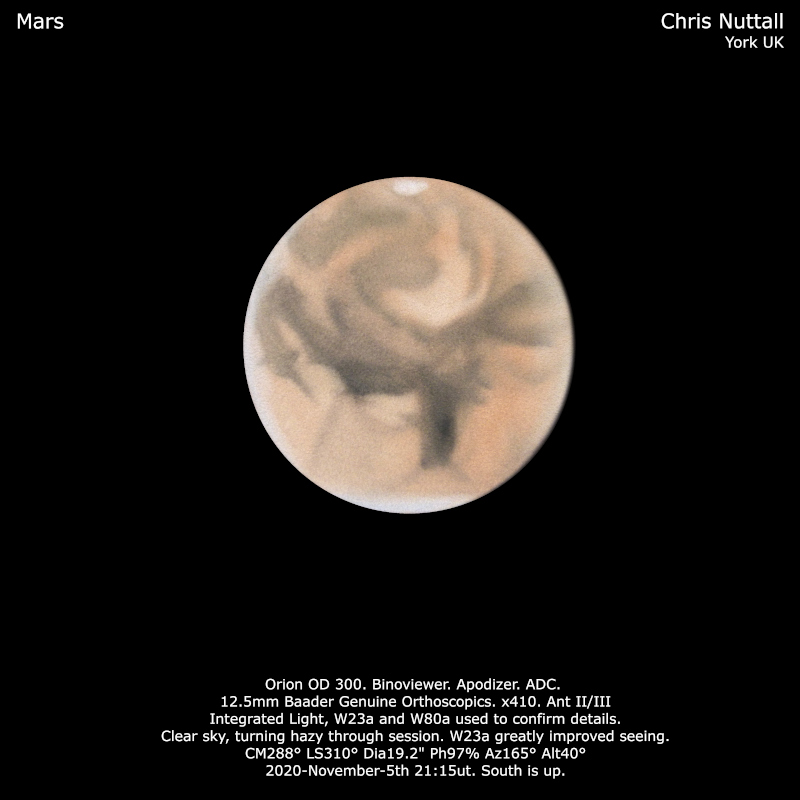 [Chris Nuttall : York,UK]
[Chris Nuttall : York,UK]
Sinus Meridiani and Margaritifer Sinus on display. Prominent morning clouds,and structure seen in NPH. Bright SPC overexposed.
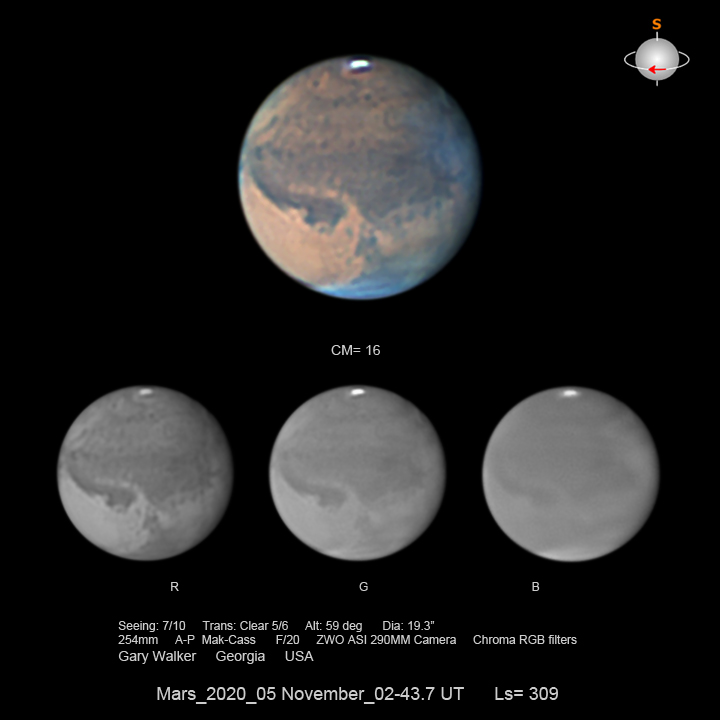 This image taken slightly later than previous and processed a bit harder so as to clearly show two small yellow clouds at Juventae Fons area.
Larger patchy clouds over Niliacus extend into NPH...? airborne dust?
This image taken slightly later than previous and processed a bit harder so as to clearly show two small yellow clouds at Juventae Fons area.
Larger patchy clouds over Niliacus extend into NPH...? airborne dust?
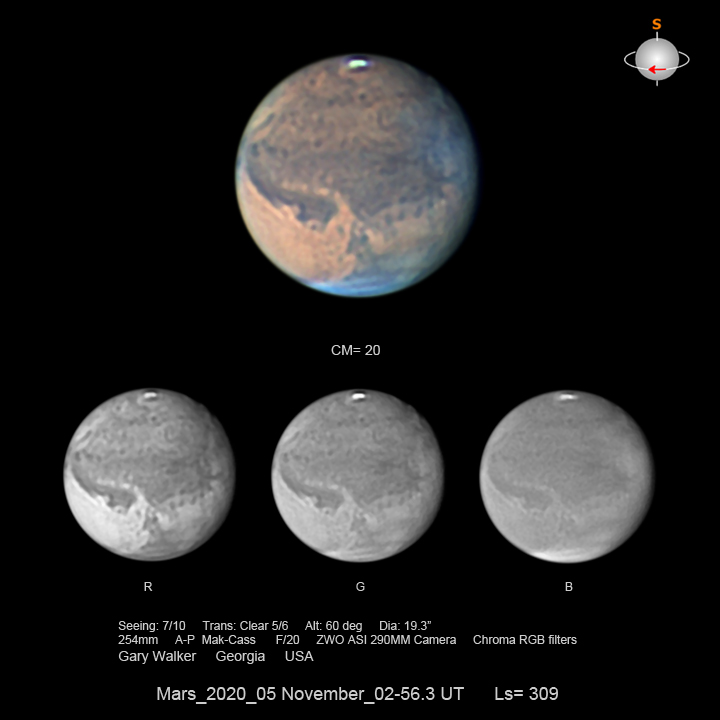 [Gary Walker:Georgia:USA]
[Gary Walker:Georgia:USA]
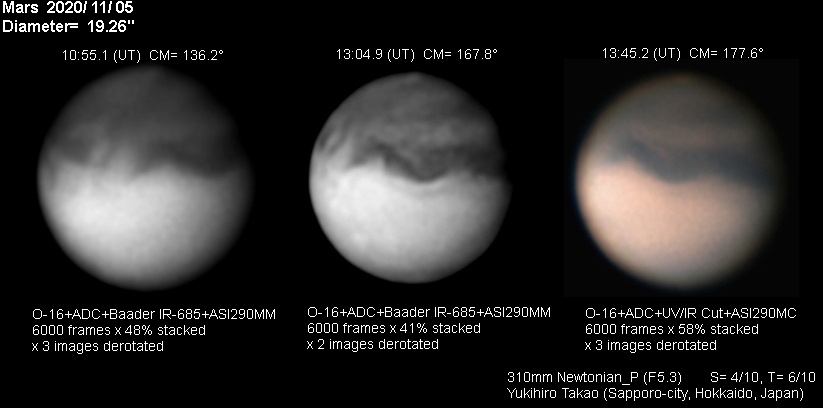 <<北海道札幌市 高尾幸弘>>[Yukihiro Takao.Sapporo-city,Hokkaido,Japan]
<<北海道札幌市 高尾幸弘>>[Yukihiro Takao.Sapporo-city,Hokkaido,Japan]
まずまずのシーイングになりましたが、ダストストームの場所は端っこ過ぎてむつかしいですね。
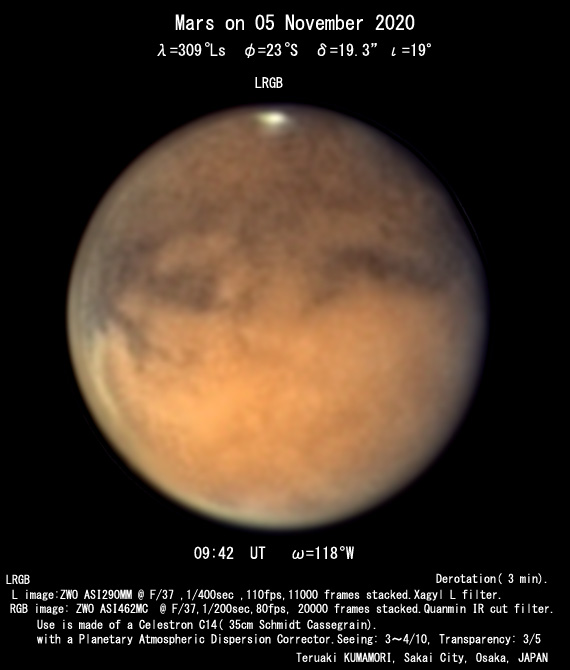
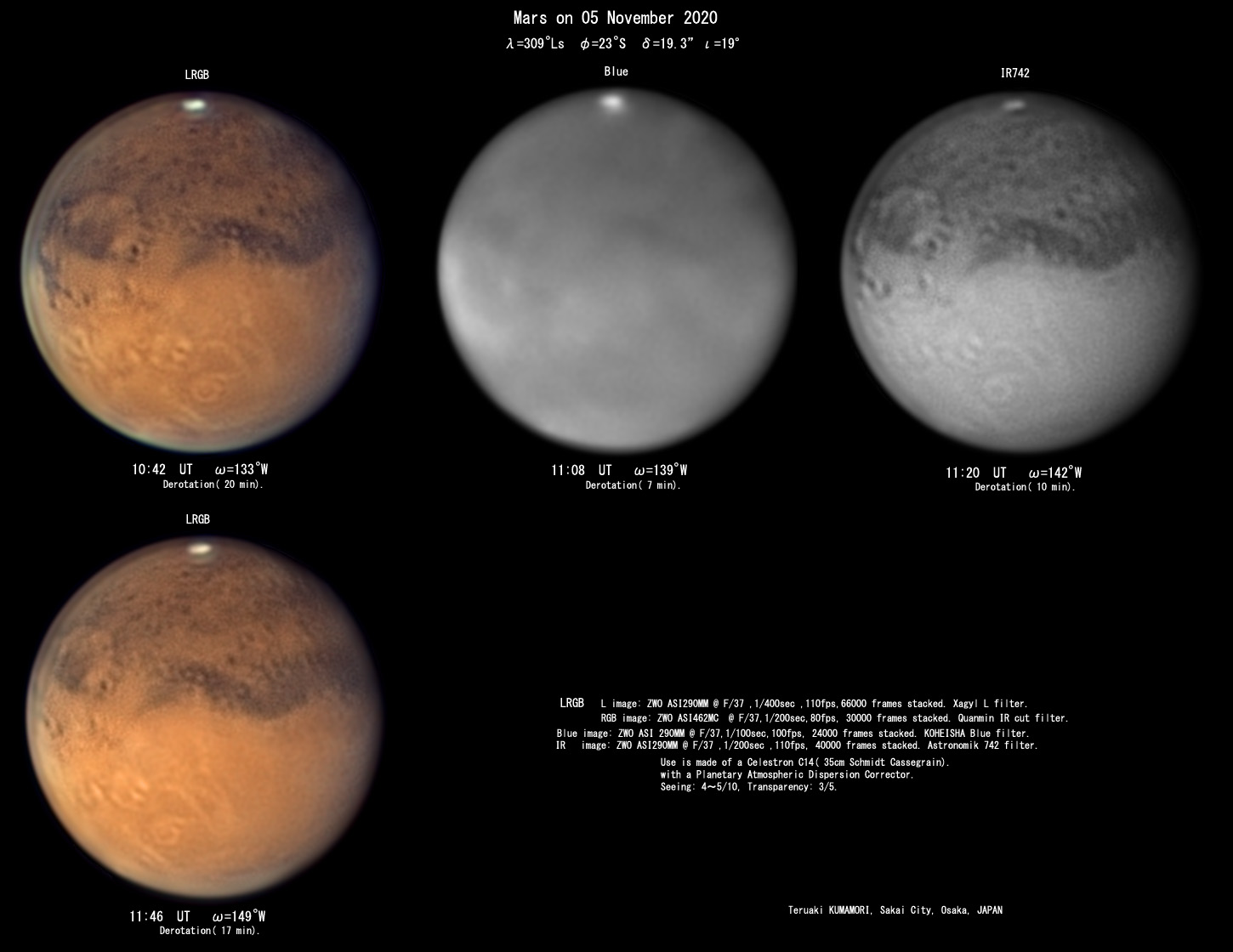 ≪大阪府堺市 熊森照明≫[Teruaki Kumamori:Ohsaka Japan]
≪大阪府堺市 熊森照明≫[Teruaki Kumamori:Ohsaka Japan]
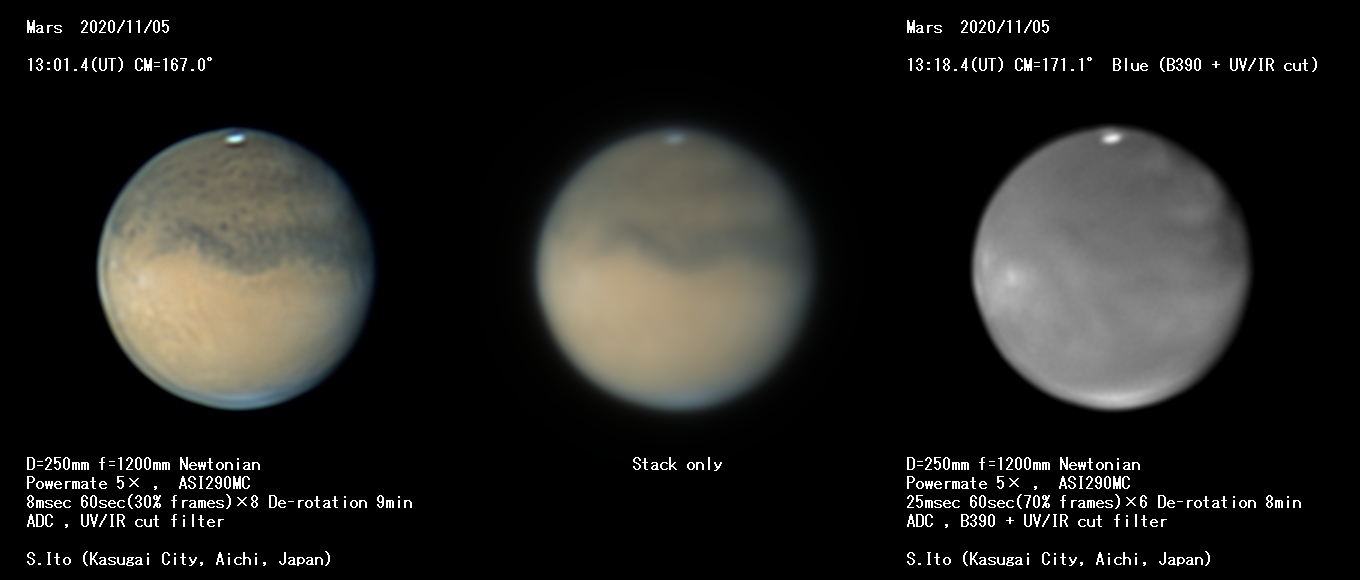 ≪愛知県 春日井市 伊藤了史≫[Satoshi Ito. Kasugai City,Aichi,Japan]
≪愛知県 春日井市 伊藤了史≫[Satoshi Ito. Kasugai City,Aichi,Japan]
寒気の影響で、なかなか良いシーイングに恵まれない。Solisが見えてくると、どうも、模様の見え方が悪くなる。淡くなって見えにくくなる。
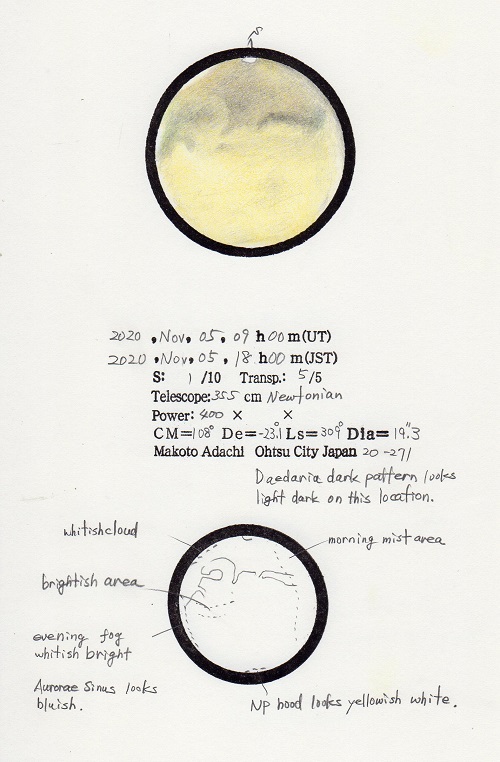
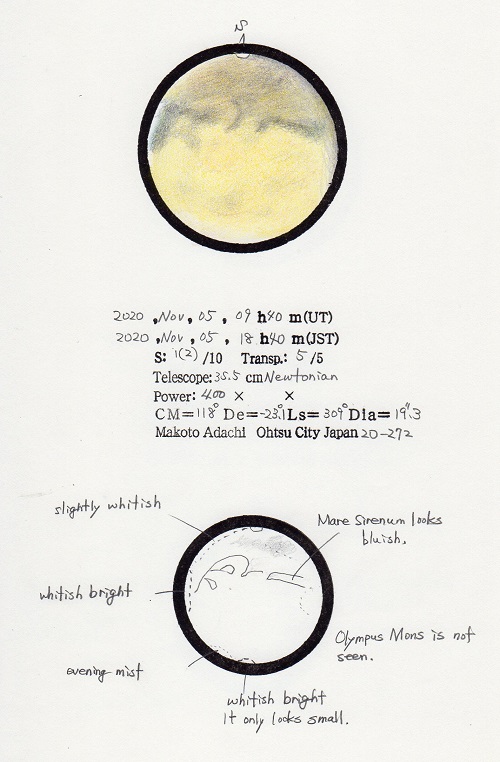

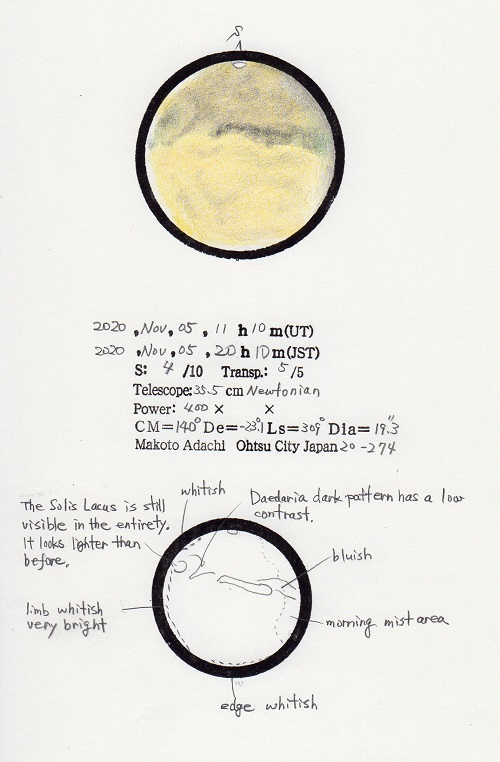 --------------------------------------------------------------
≪滋賀県 大津市 安達 誠≫[Makoto Adachi:Siga Japan]
--------------------------------------------------------------
≪滋賀県 大津市 安達 誠≫[Makoto Adachi:Siga Japan]
 [Jacques VAN DER MEER: La Ciotat (13) France]
[Jacques VAN DER MEER: La Ciotat (13) France]
To change a bit with Mars images,here are some spectra of the planet taken last week,with an Alpy 600.
The spectrograph is used with ASI183MM Pro,guiding module,and a photometric slit 23/230〓m.
Graph presented are:
1) The color spectrum of the planet. This depicts the direct spectrum that we are imaging ; this is a solar spectrum reflected by the planet's proprerties,and partially absorbed by our own atmosphere.
2) The reflectance spectrum of the planet. This describes the properties of the planet alone,without the Sun contribution.
3) A comparison with the Sun spectrum and identified features. The planet is showing basically two larges absorption bands,one in the blue/green,and another in the near IR.
4) Separated spectra of the some of the filters usually used to image the planet.
5) A synthetic colorized spectrum along with real images,for illustration.
How hard it is to image the planet in UV!
I'm sending again my spectral data,because I made one error that has been corrected.
Since I'm using a double slit (one narrow,one large),the instrumental response when using one slit or the other changes ; the narrow slit being noticeably redder than the large one.
I have been applying a coefficient to the narrow slit spectrum of Mars so that it match the profile it would have had through the large one.
Another change that I made,is that I got aware that it is more simple,and more accurate,to retrieve the reflectance spectrum of Mars simply by dividing its accurately corrected color spectrum,by the theoretical spectrum of the Sun itself.
This avoids the errors generated by the use of a star that does not exactly matches the Sun's own spectrum.
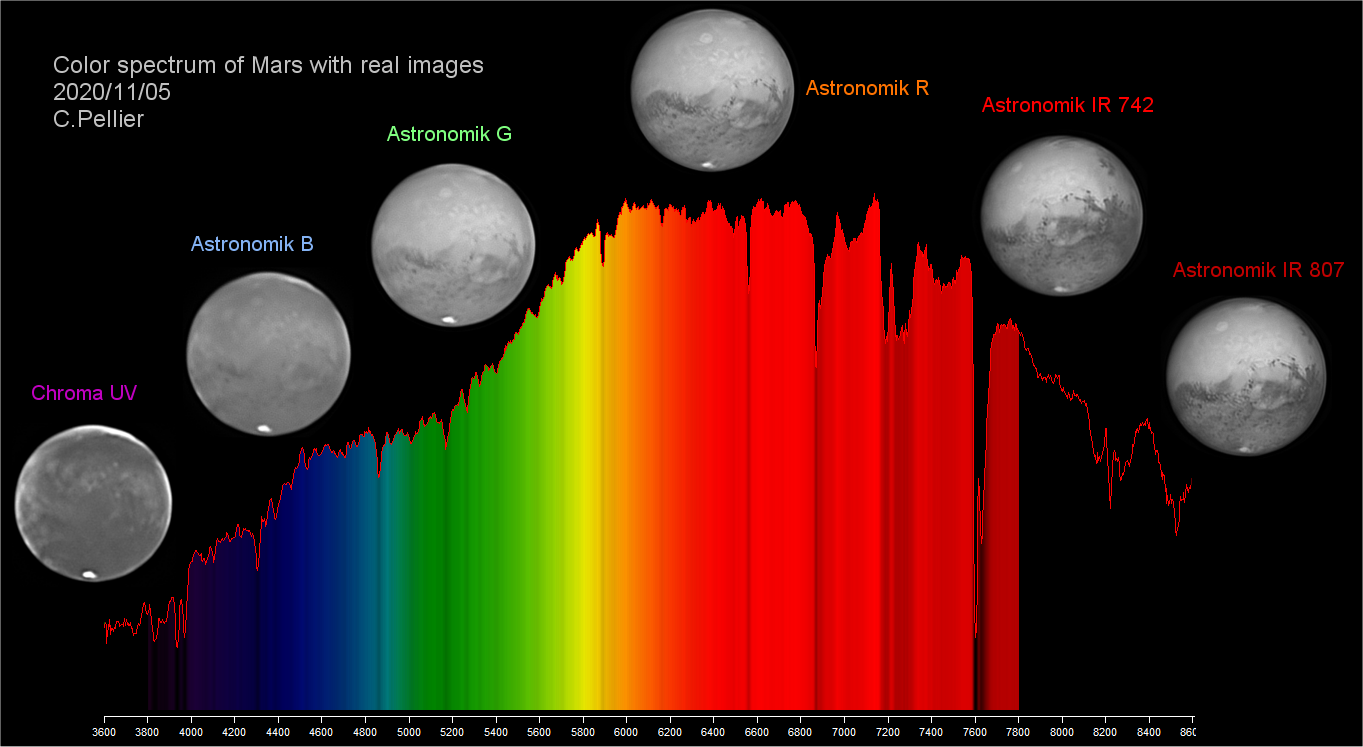
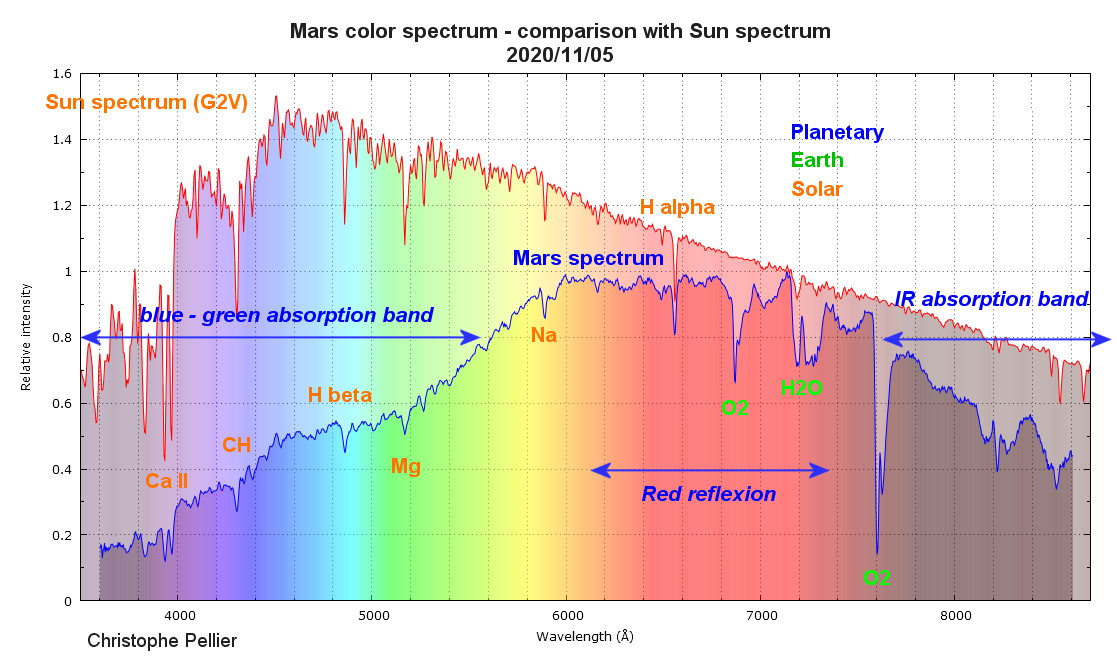 This is the corrected reflectance spectrum of Mars.
It is now more in accordance with previous data of the same kind that shew a luminosity peak around 700 nm,and not between 600 and 700 as in my last sending.
The IR part has been painfully corrected from the Earth bands turned into maths artefacts,since the Sun spectrum I used to calculate the profile does not contain those bands.
This is the corrected reflectance spectrum of Mars.
It is now more in accordance with previous data of the same kind that shew a luminosity peak around 700 nm,and not between 600 and 700 as in my last sending.
The IR part has been painfully corrected from the Earth bands turned into maths artefacts,since the Sun spectrum I used to calculate the profile does not contain those bands.
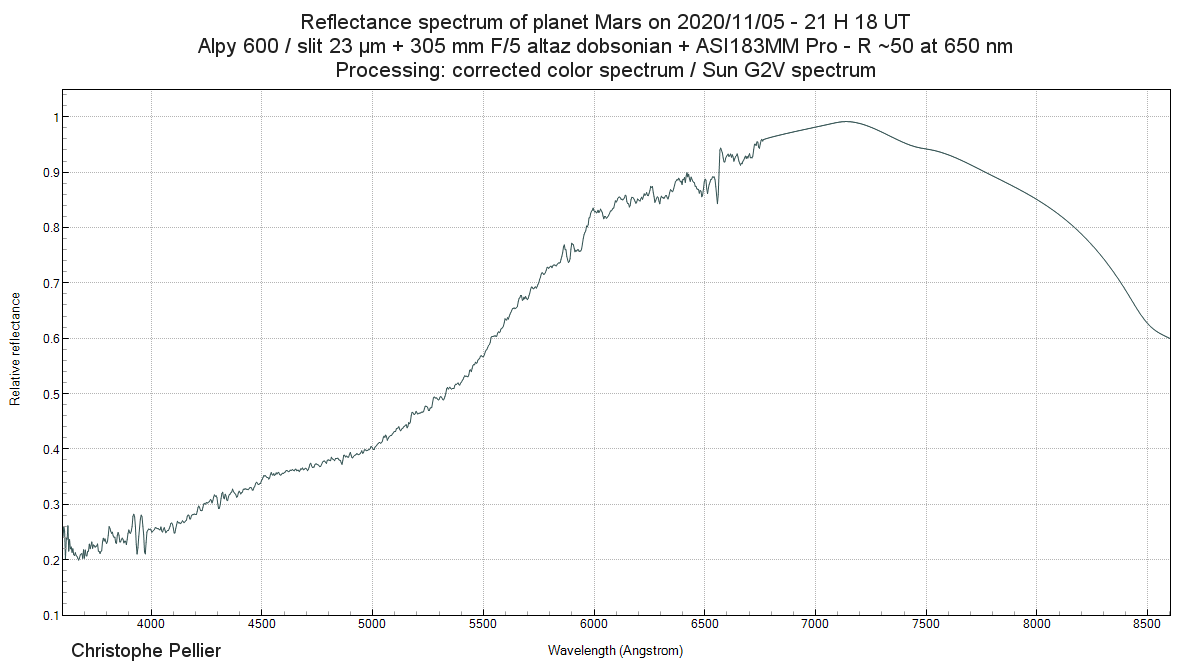

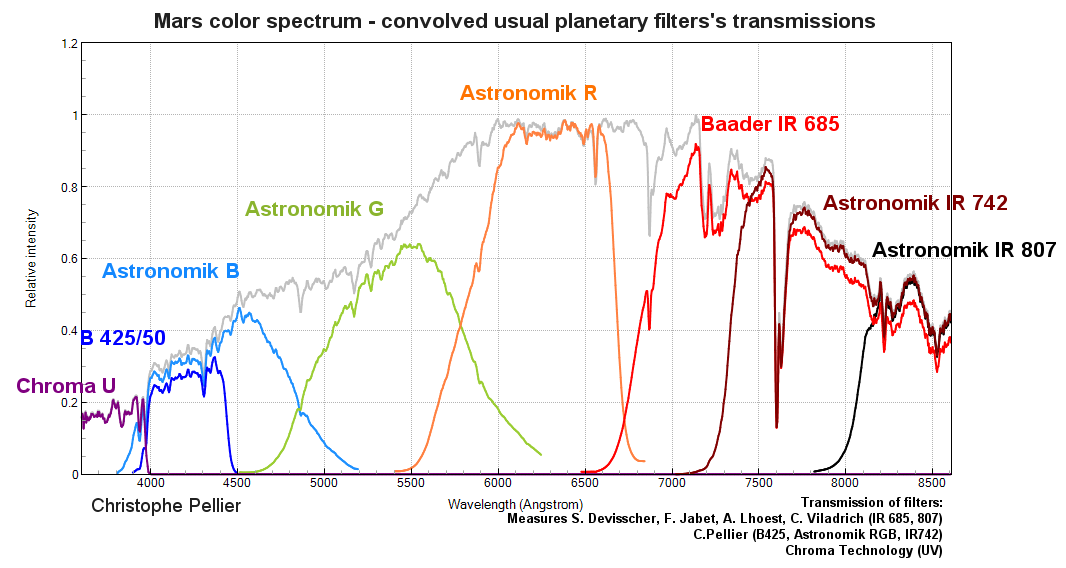 [Christophe Pellier Bruz City,France]
[Christophe Pellier Bruz City,France]
オリンポス三山が見えていました・・・・。
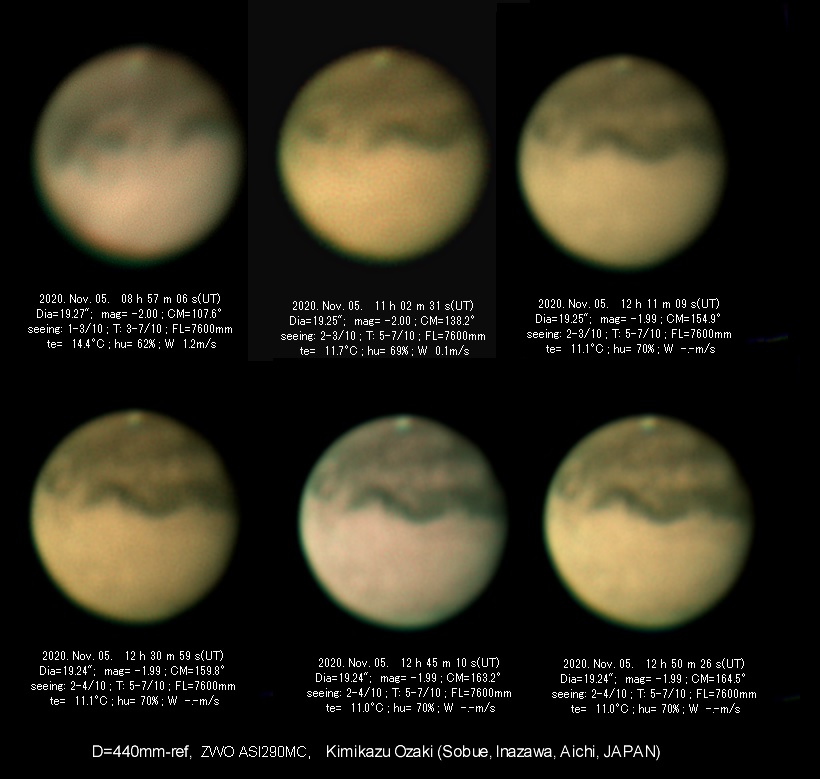 [Ki.Ozaki,Sobue Inazawa Aichi JAPAN]
≪愛知県稲沢市祖父江町 尾崎公一≫
[Ki.Ozaki,Sobue Inazawa Aichi JAPAN]
≪愛知県稲沢市祖父江町 尾崎公一≫
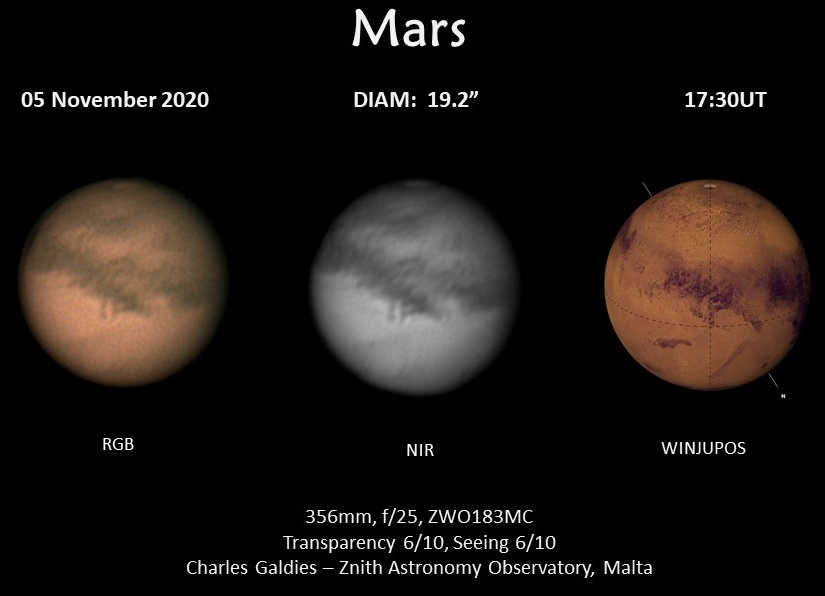
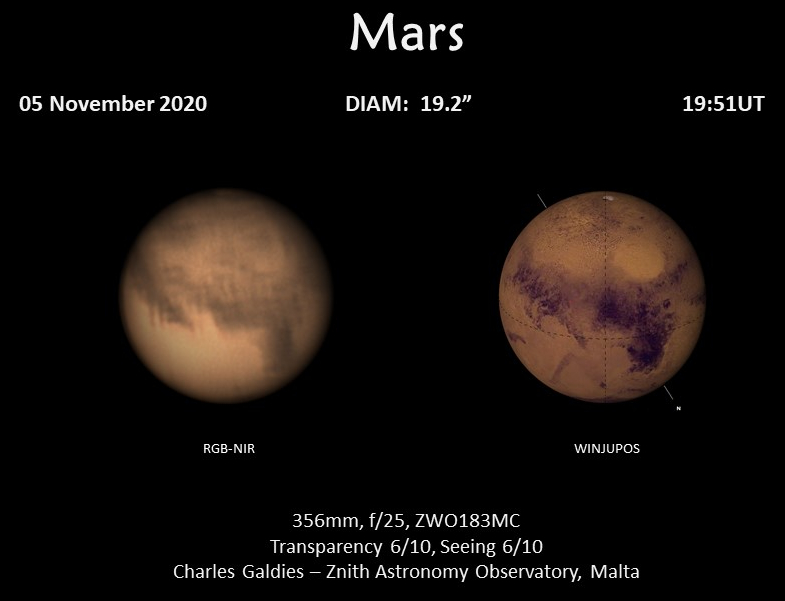 [ Charles Galdies :Naxxar-Malta]
[ Charles Galdies :Naxxar-Malta]
Good seeing. Sinus Meridiani is central with Schiaparelli crater alongside. Clouds along the terminator.
A prominent rift bisects the south polar cap at bottom. Huygens crater is also nicely seen over on the right.
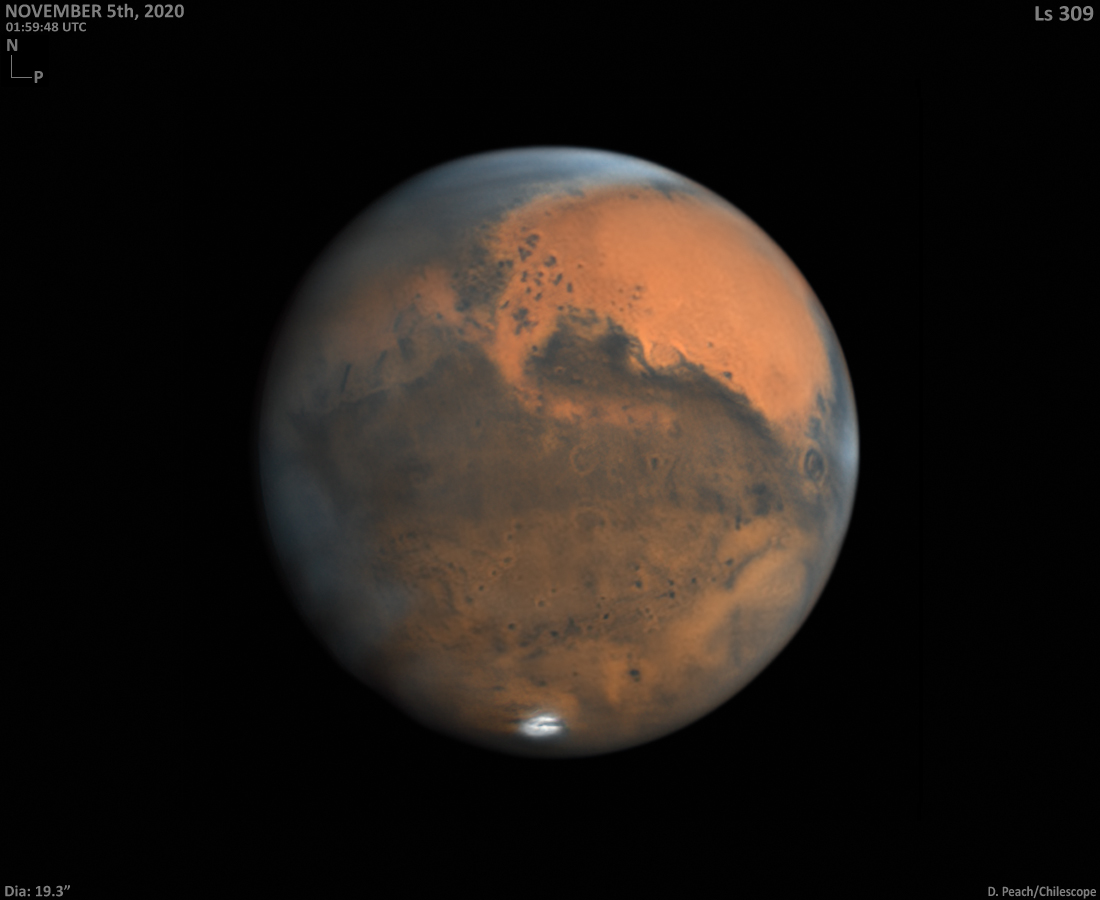 [Damian Peach: Loudwater,Buckinghamshire,United Kingdom]
[Damian Peach: Loudwater,Buckinghamshire,United Kingdom]


 -----------------------------------------------------
[Sagamihara-shi Kanagawa-prefecture Japan]
≪神奈川県相模原市 佐藤康明≫
-----------------------------------------------------
[Sagamihara-shi Kanagawa-prefecture Japan]
≪神奈川県相模原市 佐藤康明≫ ≪奈良県奈良市 荒川 毅≫[Tsuyoshi Arakawa:Nara Japan]
≪奈良県奈良市 荒川 毅≫[Tsuyoshi Arakawa:Nara Japan] [Kenkichi Yunoki (Sakai City,Japan)]
≪大阪府 堺市 柚木健吉≫
[Kenkichi Yunoki (Sakai City,Japan)]
≪大阪府 堺市 柚木健吉≫ ≪神奈川県 横浜市 三品利郎≫[Toshirou.Mishina:Kanagawa Japan]
≪神奈川県 横浜市 三品利郎≫[Toshirou.Mishina:Kanagawa Japan] ≪滋賀県守山市 森田光治≫[Mitsuji Morita:Siga Japan]
≪滋賀県守山市 森田光治≫[Mitsuji Morita:Siga Japan] (Tutomu-Ishibashi Kanagawa-P Japan)
≪神奈川県 相模原市 石橋力≫
(Tutomu-Ishibashi Kanagawa-P Japan)
≪神奈川県 相模原市 石橋力≫ ≪大阪府 枚方市 井上 修≫[Osamu Inoue. Hirakata-shi,Osaka,Japan]
≪大阪府 枚方市 井上 修≫[Osamu Inoue. Hirakata-shi,Osaka,Japan] [Masaaki Nagase,Kawasaki-City,Japan]
[Masaaki Nagase,Kawasaki-City,Japan] ≪茨城県 : 阿久津富夫≫
≪茨城県 : 阿久津富夫≫ [Kevin Quin:Vienna,VA,USA]
[Kevin Quin:Vienna,VA,USA] [Shigeru Kurisu,Mitoyo Kagawa,Japan]
[Shigeru Kurisu,Mitoyo Kagawa,Japan] [Randy B. Christensen,Livermore,California,US]
[Randy B. Christensen,Livermore,California,US] <<神奈川県 藤沢市 西岡達志>>[Tatsushi Nishioka. Fujisawa-city,Kanagawa,Japan]
<<神奈川県 藤沢市 西岡達志>>[Tatsushi Nishioka. Fujisawa-city,Kanagawa,Japan] [Stephen James O'Meara : Maun,Botswana]
[Stephen James O'Meara : Maun,Botswana] [Peter Edwars: West Sussex United Kingdom]
[Peter Edwars: West Sussex United Kingdom]

 [ Randy Tatum,Richmond,VA U.S.A]
[ Randy Tatum,Richmond,VA U.S.A] ≪石川県小松市 大杉忠夫≫[Tadao Ohsugi:Komatsu city Ishikawa pre,Japan]
≪石川県小松市 大杉忠夫≫[Tadao Ohsugi:Komatsu city Ishikawa pre,Japan] [Dmitry W. von Aichegg : Domodedovo,Moscow Russia]
[Dmitry W. von Aichegg : Domodedovo,Moscow Russia] [Stanislas Maksymowicz Ecquevilly,France]
[Stanislas Maksymowicz Ecquevilly,France] ≪東京都 立川市 皆川伸也≫[Nobuya Minagawa:Tokyo Japan]
≪東京都 立川市 皆川伸也≫[Nobuya Minagawa:Tokyo Japan] [Siegfried Gonzi : Exeter,United Kingdom]
[Siegfried Gonzi : Exeter,United Kingdom] [スセンバッハ:オランダ]
[John Sussenbach:Houten,Netherlands]
[スセンバッハ:オランダ]
[John Sussenbach:Houten,Netherlands] [Chris Nuttall : York,UK]
[Chris Nuttall : York,UK] This image taken slightly later than previous and processed a bit harder so as to clearly show two small yellow clouds at Juventae Fons area.
Larger patchy clouds over Niliacus extend into NPH...? airborne dust?
This image taken slightly later than previous and processed a bit harder so as to clearly show two small yellow clouds at Juventae Fons area.
Larger patchy clouds over Niliacus extend into NPH...? airborne dust?
 [Gary Walker:Georgia:USA]
[Gary Walker:Georgia:USA] <<北海道札幌市 高尾幸弘>>[Yukihiro Takao.Sapporo-city,Hokkaido,Japan]
<<北海道札幌市 高尾幸弘>>[Yukihiro Takao.Sapporo-city,Hokkaido,Japan]
 ≪大阪府堺市 熊森照明≫[Teruaki Kumamori:Ohsaka Japan]
≪大阪府堺市 熊森照明≫[Teruaki Kumamori:Ohsaka Japan] ≪愛知県 春日井市 伊藤了史≫[Satoshi Ito. Kasugai City,Aichi,Japan]
≪愛知県 春日井市 伊藤了史≫[Satoshi Ito. Kasugai City,Aichi,Japan]


 --------------------------------------------------------------
≪滋賀県 大津市 安達 誠≫[Makoto Adachi:Siga Japan]
--------------------------------------------------------------
≪滋賀県 大津市 安達 誠≫[Makoto Adachi:Siga Japan] [Jacques VAN DER MEER: La Ciotat (13) France]
[Jacques VAN DER MEER: La Ciotat (13) France]
 This is the corrected reflectance spectrum of Mars.
It is now more in accordance with previous data of the same kind that shew a luminosity peak around 700 nm,and not between 600 and 700 as in my last sending.
The IR part has been painfully corrected from the Earth bands turned into maths artefacts,since the Sun spectrum I used to calculate the profile does not contain those bands.
This is the corrected reflectance spectrum of Mars.
It is now more in accordance with previous data of the same kind that shew a luminosity peak around 700 nm,and not between 600 and 700 as in my last sending.
The IR part has been painfully corrected from the Earth bands turned into maths artefacts,since the Sun spectrum I used to calculate the profile does not contain those bands.


 [Christophe Pellier Bruz City,France]
[Christophe Pellier Bruz City,France] [Ki.Ozaki,Sobue Inazawa Aichi JAPAN]
≪愛知県稲沢市祖父江町 尾崎公一≫
[Ki.Ozaki,Sobue Inazawa Aichi JAPAN]
≪愛知県稲沢市祖父江町 尾崎公一≫
 [ Charles Galdies :Naxxar-Malta]
[ Charles Galdies :Naxxar-Malta] [Damian Peach: Loudwater,Buckinghamshire,United Kingdom]
[Damian Peach: Loudwater,Buckinghamshire,United Kingdom] ALPO-Japan Latest
ALPO-Japan Latest